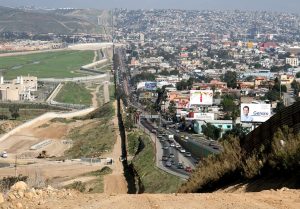US asylum system under pressure
Title 42, the Trump-era border control measure brought in during the COVID-19 pandemic, has been lifted by the US Government but confusion still characterises US asylum arrangements.
The end of Title 42 saw a rush of asylum seekers and migrants across the US-Mexico border.
Enacted in March 2020, the public health order allowed the United States to rapidly expel 2.6 million people entering irregularly back to Mexico over the past three years without letting them apply for asylum.
But, apart from opening up a limited number of legal pathways for people to reach the United States, the Biden administration has introduced further asylum restrictions.
 Some reports say migrants processed into the US as asylum seekers are being given immigration court dates more than a decade away.
Some reports say migrants processed into the US as asylum seekers are being given immigration court dates more than a decade away.
Backlogs at immigration courts currently stand at 2.1 million cases waiting to be heard.
There are around 600 immigration court judges deciding asylum cases, and in the last financial year, they closed approximately 312,000 cases.
According to data from the Justice Department, 2022 saw the highest number of asylum applications on record, with almost 700,000 filed.
That record could be broken this year, with projections based on first-quarter figures to be almost 740,000 applications filed.
With the end of Title 42 is lifted, tens of thousands of people who have been waiting in Mexico after fleeing from violence, poverty and political instability are once again subject to decades-old immigration protocols known as Title 8.
Under these laws, individuals can no longer be turned away or deported without a screening for asylum claims.
That means they’ll enter the US and be placed in detention centres as they go through a process called expedited removal, which includes a credible fear interview.
Those who are deemed to have valid claims will be allowed to stay in the country as their cases make their way through immigration court. Those who are not will be deported.
But the longer processing times will likely result in a bottleneck at ports of entry and detention centres that will put a strain on federal, state and local government resources.
The return of Title 8 may be a lifeline for migrants who have been stuck in overcrowded shelters or have been living on the streets of Mexican border cities.
However, the protocols also carry stiffer penalties for migrants who are caught crossing the border illegally, including the possibility of a five-year ban on entry to the US for migrants who are deported.
The US will continue to admit 30,000 migrants a month from Venezuela, Cuba, Haiti and Nicaragua, as long as they have applied online and have secured a financial sponsor.
Mexico has agreed to continue taking back the same number who cross illegally.
Meanwhile, the UN has called on the Biden administration to provide more pathways to refugee settlement.
“Title 42 was lifted by the US government – new, safe pathways and increased refugee resettlement are welcome, but measures restricting access to asylum are of concern,” said UNHCR chief Filippo Grandi.












